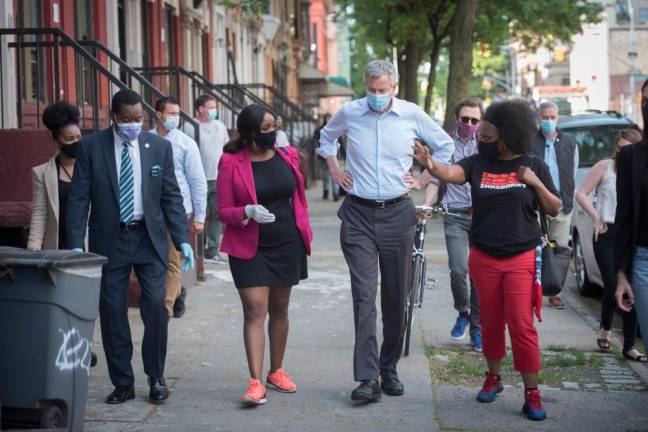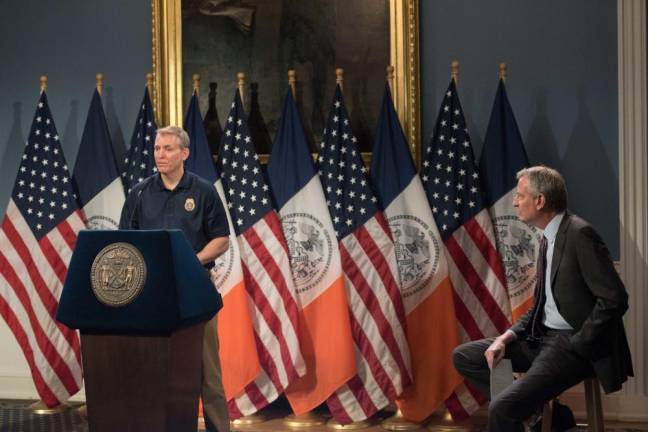De Blasio’s Reckoning
The mayor seems overwhelmed by how the pandemic and the protests dramatize the “two cities” of New York he promised to bridge


He was elected on a pledge to bridge the “two cities” of New York, one rich and privileged, the other poor and pressured. Yet, as he approaches the end of his tenure, Mayor Bill de Blasio seems overwhelmed by the conflicts this divide has generated.
To be sure, few of us have lived through days like these, when crises pile on each other - a hundred-year pandemic stoking grief and anger, which then boils over as yet another African American man dies in the custody of police in yet another American city.
Our president has not made the job of local leaders easier, warning that looters could be shot, then jetting off to Florida to revel in the dawn of commercial manned space flight.
As some sought escape into space, others here yearned to go back in time. It was striking this weekend that more than a few New Yorkers invoked images of the mayor from the silk-stocking East Side, who strode Harlem in his shirt sleeves in an earlier crisis.
John Lindsay and Bill de Blasio each came to office as a progressive. Lindsay, however, had a gift for the message, the moment and even the happening, while de Blasio has struggled to hit the high notes of leadership in a city desperate for it.
“America’s largest city has no mayor,” Bronx Council Member Ritchie Torres tweeted on Saturday.
Disappointed Progressives
Torres, one of several Democrats running for Joe Serrano’s South Bronx Congressional district, encapsulated a sense of unfilled political space that was articulated widely, if not always as extremely, across a political spectrum of New Yorkers, from conservatives who have never liked de Blasio’s message of class conflict to progressives disappointed that he has not accomplished more to win it.
A chorus of progressives, from Rep. Alexandria Ocasio-Cortez to former members of the mayor’s own staff expressed disappointment over the weekend in his handling of the street protests and the clashes between demonstrators and the police. A common refrain was that the mayor had lost control of the police department he had promised to reform.
Just as the coronavirus laid bare the profound racial and economic schisms that helped propel de Blasio into office, the pandemic and the protests have tested his capability to do the job.
Being NYC’s mayor is hard. Lindsay called it the second toughest job in America. It demands both administrative skill and a supreme capacity to identify and elevate commonality amidst the chaos and cacophony of the great city.
While de Blasio tried as best he could to stand with the protestors while voicing support for the difficult challenge of being a police officer, he left neither group satisfied. “I don’t think I expressed it as well as I should have,” the mayor explained Monday.
The critique of the mayor’s management of the NYPD had echoes of the fierce criticism he has taken for his administrative choices during the pandemic, particularly his decision to strip the Health Department of oversight of tracing the contacts of New Yorkers infected with coronavirus. “Disastrous,” said Dr. Tom Frieden, former city health commissioner and the former head of the Centers for Disease Control.
It is easy to find shortcomings in any leader’s management during a crisis. The far more significant question about de Blasio is whether falling short of his own vision has left the city more vulnerable to the pandemic and the protests and fiscal crisis that have now followed.
Imagine, for example, if the city had built over his six years in office the holistic care for low-income communities that his own health commissioner talks about. High blood pressure would be less common. Diabetes and asthma would be better managed. Obesity would be reduced and nutrition would be improved.
The disparity in COVID-19 deaths by race and ethnicity would thus have been reduced.
That disparity is, ultimately, the reckoning COVID-19 and George Floyd demand of us.
“Hot Spots”
For all de Blasio’s progressive talk, the death rate from COVID-19 for African Americans in NYC has been almost identical to the national rate, which is to say better than some places yet still disturbingly higher than the death rate for whites. And Latino New Yorkers have died at the highest rate for Hispanics anywhere in the United States.
Indeed, even as Torres was wondering where the mayor had gone Saturday, it was Gov. Andrew Cuomo, not the mayor, who was announcing a plan to contain coronavirus this week in ten infection “hot spots” in the city. These were the ten zip codes with the highest rates of infection. Six were in the South Bronx, in and around the congressional district Torres is running to represent.
The governor, who learned well from his father the magic of the right words in the right moment, paired this announcement with a second. He signed a bill to give death benefits to families who lost frontline workers to the coronavirus.
“I think our better angels won; our better angels rose to the occasion,” Cuomo said. “We helped each other — we protected each other ...We needed people to rise above themselves to get past the pettiness to be bigger than themselves and they did it.”
The beneficiaries include the families of police officers who died of COVID-19.
“America’s largest city has no mayor.” Tweet from Bronx Council Member Ritchie Torres